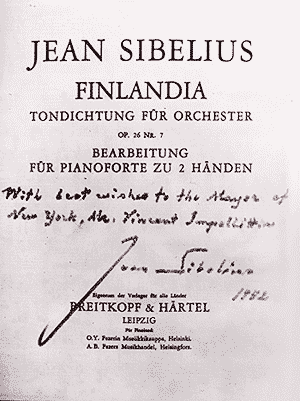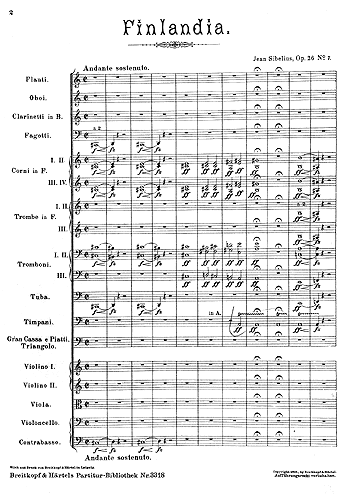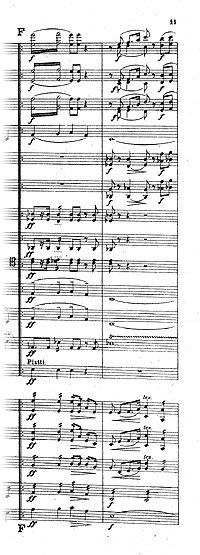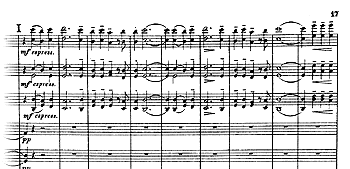
[Op. 25/26] Music for the Days of the Press. Tableau music for celebrations in honour of the Finnish Press (tableaux by Kaarlo Bergbom, texts by Eino Leino and Jalmari Finne); overture and six tableaux (revised versions: see orchestral works op. 25 and 26). Completed in 1899; first performance at the Swedish Theatre in Helsinki, 4th November 1899 (Orchestra of Helsinki Philharmonic Society under Jean Sibelius).
Op. 26 Finlandia, symphonic poem
In revised version (1900) of the music (composed 1899) for celebrations in honour of the Finnish Press (7th movement, under title "Finland Awakens"): first public performance 2nd July 1900 (possibly earlier), in the premises of the Fire Brigade (Orchestra of the Helsinki Philharmonic Society under Robert Kajanus). Conducted by Kajanus as Finlandia, February 1901. Arrangement for piano (under name Finlandia) November 1900.Arrangements for male choir of the Finlandia Hymn with words by: a) Wäinö Sola 1937; first performance 21st April 1938 in Helsinki at Freemason's Lodge of St John (singers Wäinö Sola, Martti Similä, Sulo Räikkönen and O. A. Turunen, with Arvi Karvonen at the harmonium); b) Veikko Antero Koskenniemi 1940; first performance 7th December 1940 at the Exhibition Hall in Helsinki (Laulu-Miehet singers under Martti Turunen). Arrangement for mixed-voice choir of the Finlandia Hymn 1948; words by V. A. Koskenniemi.
In February 1899 Nicholas II, Emperor of Russia, issued a "February Manifesto" which aimed to restrict the autonomy of the Grand Duchy of Finland. This stirred opposition in most Finnish cultural circles, and paintings with protest themes became very popular.
Sibelius, too, wanted to use his art to add to the protests. In 1899 he wrote The Song of the Athenians and The Breaking of the Ice on Oulu River. The year was crowned by the music for tableaux staged as part of the main event of the Days of the Press. The performances took place at the beginning of November 1899 at the Swedish Theatre.
Sibelius wrote a short overture, and music for six tableaux:
I Väinämöinen's Song,
II The Baptism of the Finns [into the Christian faith]
III Duke John in the Castle of Turku,
IV Finns in the Thirty Years' War,
V The "Great Hate" [referring to the scorched-earth and reprisal tactics of the Russian Army during its invasion of Finland, 1714-1721],
VI Finland Awakens.
In addition, he composed "quiet music" to complement the texts of the tableaux.
The tableaux depicted scenes from the history of Finland. The tableau from the period of the 'Great Hate' was especially bold, as it showed the destruction caused by the Russian conquerors. Now the same conquerors were censoring the Finnish press. Officially, the ticket receipts from the performance were to go to the journalists' pension fund. At the same time Finnish cultural figures wanted to support freedom of speech in defiance of Governor-General Nicholas Bobrikov.
In the "Great Hate" tableau the performance had a particularly sharp edge. Mother Finland was sitting in a snowdrift with her children who were shivering with cold. They were threatened by War, Frost, Hunger and Death. Sibelius composed the darkest and most ascetic music imaginable.
This was the starting point for the last tableau, "Finland Awakens", to which Eino Leino hade written a suitably solemn background text. The defiant brass chords of the opening made a deep impression on the young Heikki Klemetti, who was in the audience. "Those grand, gloomy themes at the beginning of what is now Finlandia rolled across the tableau depicting the horrors of the 'Great Hate'", Klemetti wrote later.
"Finland Awakens" was indeed an early version of Finlandia. It is interesting that Klemetti – who was an eye-witness - reports the Finlandia music as beginning during the tableau that described the 'Great Hate'. Thus the first notes of Finlandia cannot describe the chuffing of a steam locomotive - as has been humorously claimed. It is true that a locomotive did make an appearance in the tableaux, but according to the manuscript that was only after a description of the reign of Tsar Alexander II, including the heroic accomplishments of Runeberg the poet, Snellman the statesman and Lönnrot the compiler of Kalevala..
Finlandia was certainly not composed to describe these various stages in any precise way. What Sibelius wanted was to portray Finland's awakening and its fighting spirit in more general terms. Later Sibelius told Jalmari Finne that he had no idea that there was anything special about Finlandia. It was not until he took the score to the copyist Ernst Röllig that it occurred to him that there might be something out of the ordinary in the composition.
During the following months Kajanus and Sibelius conducted the best pieces of the tableau music in Helsinki and Turku. They decided to take the finale of the suite on the European tour of Kajanus's orchestra. The tour would end at the World Exhibition in Paris. Axel Carpelan became nervous: "Why will only the last piece of this suite,
which is written in a "symphonic style" (probably the best), be played in Paris? If I can trust what others have told me about this tableau music, the music should be played in its entirety or at least 4 movements of it. And I wonder if the title 'La Patrie' is a good idea?"
It turned out to be difficult to find a suitable title for the composition: in previous concerts it had been Finland, The Awakening of Finland or Finale. On the tour, it was called Vaterland and La Patrie (and possibly other titles). However, in November 1900 the piano arrangement of the tableau was given the name Finlandia - a title suggested by Axel Carpelan - and in February 1901 Kajanus finally conducted the orchestral version of the work under the name Finlandia. Soon the work was printed in an improved version. As early as 1909 an excerpt was recorded under Ronald Landon.
"What is so attractive about this symphonic poem? Surely it is its 'plein air' style. Really, it is based entirely on themes 'given from above'. Pure inspiration," the composer wrote in his diary in 1911.
In the same year Sibelius prepared a revised orchestral suite from those other tableau pieces that he considered of suitable quality; the suite was called Scènes historiques I. The original tableaux were revised as late as 28th February 1921. It was only in the late 1990s that the original tableau music was recorded for the first time, by Tuomas Ollila and Tampere City Orchestra. Since then the Lahti Symphony Orchestra has also recorded the original tableau music.
Finlandia became a world favourite, and many arrangements were made of it: an arrangement for military band in 1909, a choral and orchestral version in English in 1925, and an arrangement for marimba orchestra in the 1940s. Sibelius heard a version given by a restaurant trio in Bergen in 1921 and politely asked the musicians not to play it.
The hymn episode, which was well suited for singing, posed a problem of its own. Soon Finlandia was being sung round the world with words such as Be Still My Soul, At the Table, Dear Friend of Mine, Land of the Pine, Christian Life and Our Farewell Song.
"It is not intended to be sung," Sibelius complained. "It is written for an orchestra. But if the world wants to sing it, it can't be helped."
In Finland, too, people plucked up courage. Early text drafts were written by Jalmari Finne and Yrjö Sjöblom. The tenor Wäinö Sola sent his own version to Sibelius in 1937. After revisions, Sibelius (now aged over 70) prepared from Sola's text a version for male choir, for use by the Freemasons.
However, it was the lyrics by V. A. Koskenniemi that became more popular. This version was commissioned by Laulu-Miehet (the "Song Men"). Martti Turunen's letter to the composer from September 1940 shows the background to the commission:
"Some time ago Laulu-Miehet contacted Professor Koskenniemi and asked him for a text to Finlandia. Professor Koskenniemi agreed and sent his suggestion for a poem, which finally took the following shape. Laulu-Miehet would like to perform Finlandia with these words, if you, Professor Sibelius, give your consent."
Sibelius consented to the request. Koskenniemi's poem won the hearts of the Finns both in the collection Latuja lumessa (1940) and as words to the hymn section of Finlandia.
Finlandia starts with a threatening motif in the brass, which immediately increases from forte to fortissimo.

The first page of Finlandia. Breitkopf & Härtel.
The answer of the woodwinds is elevated: it could even be said to breathe a sense of holiness. The strings introduce a more "human" voice. After a slow introduction the tempo changes to Allegro moderato. The fanfare of the brasses reveals a fighting spirit. With the tempo allegro there comes a feeling of confidence.

Finlandia, excerpt from page 11. Breitkopf & Härtel.
The world-famous hymn motif is first heard in the woodwinds.

Finlandia, excerpt from page 17. Breitkopf & Härtel.
The strings continue to play the hymn theme, which Leopold Stokowski suggested as a national anthem for the whole world. After the hymn the tempo becomes faster, the brass fanfares return, and the short symphonic poem rushes to its triumphant end as the hymn theme continues to play, augmented by the brass.
"Everybody else [except the critics] cheers at this composition, which is insignificant compared with my other works," was Sibelius's puzzled comment in 1911. And when fan mail was being opened in Ainola 30 years later, there was usually no sympathy for those who mentioned only Valse triste and Finlandia.
"If there was only mention of these works and not of any greater works, we presumed that the person making the request [for an autograph] was no serious friend of music," Sibelius's private secretary Santeri Levas wrote.
But the aged composer admitted the value of these works. "Well, I wouldn't put it quite like that. They are good compositions, both of them," he said.

